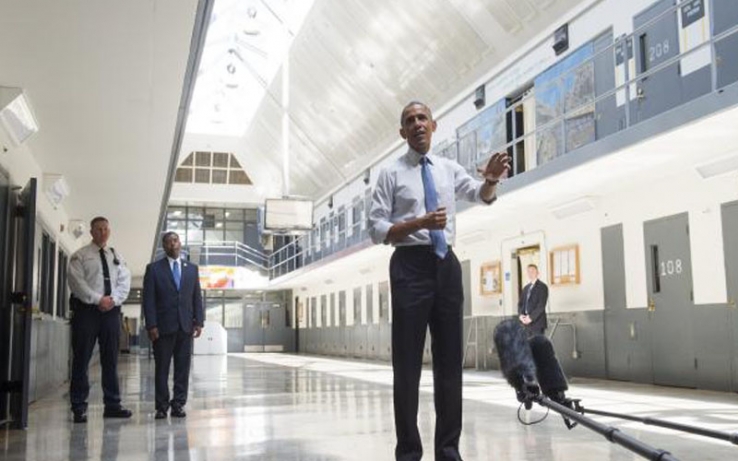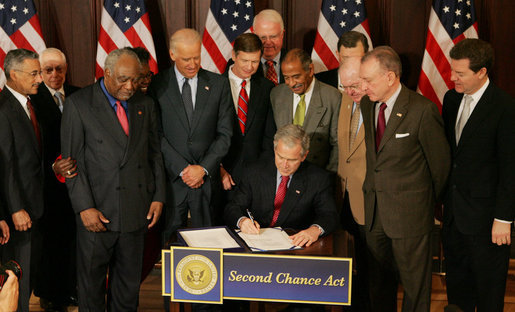
President Obama visits El Reno Federal Penitentiary on July 16, 2015
The reality of criminal convictions and imprisonment is that most individuals who have run afoul of the law and incarcerated, will be released and return to their home community. It is why in the last decade momentum has built around the issue of reentry and the need for services to facilitate a successful transition back to society. The United States Department of Justice (DOJ) estimates that in excess of 600,000 individuals return to their home neighborhoods upon their release from state and federal correctional facilities. DOJ also notes that another 11.4 million individuals cycle through local jails and one quarter of Americans has had an encounter with the criminal justice system, mostly for non-violent offenses.
The Department of Justice has designated the week of April 24-30 as National Reentry Week. The federal Bureau of Prisons will coordinate events at facilities across the country – job fairs, interview training, mentorship programs and events for children – all designed to assist inmates prepare for their release. Attorney General Loretta E. Lynch has also instructed each U.S. Attorney’s Office to coordinate reentry events, including meetings with community stakeholders, employer roundtables and any activities to raise awareness of reentry needs. Justice Department officials will travel to events across the country during National Reentry Week.
For many years it was the faith-based community that took the lead in servicing the incarcerated through a myriad of ‘prison ministries.’ While these efforts were commendable, they did not meet the tremendous needs of this population. Incarceration removes individuals from the labor market and erodes work skills, the dearth of prison education programs provides little opportunity for individuals to expand their knowledge base, prison environments cause tremendous healthcare issues within the incarcerated population, and family bonds are severed due to several factors; including the distance of correctional facilities to home neighborhoods, excessively high collect calling telephone rates that burden families, and tensions over the economic and emotional impact incarceration has on households.

President George W, Bush signs the Second Chance Act on April 9, 2008
Reentry has evolved in recent years into a nonpartisan issue with Republicans and Democrats pushing for a lessening of mass incarceration. The federal Second Chance Act, adopted by Congress and signed into law by President George W. Bush on April 9, 2008, was the first recognition by federal lawmakers that the nation had reached the limits of incarceration as a tool for public safety. The rising costs of incarcerating individuals for minor, non-violent offenses, exacerbated by the 1994 federal crime bill, began to take a toll on states and governors began to see the tremendous cost of the “tough on crime” attitude that had taken roots in the early 1990s. It was also evident that a different approach was necessary given rates of recidivism and the burden on families and communities when large numbers of individuals continually cycled through the criminal justice system.
Upon release too many individuals find that they face lasting penalties. Despite recent efforts to confront discriminatory hiring practices in some states, far too many of the formerly incarcerated are denied opportunities to re-enter the labor market. It is also difficult for individuals to resume their education, either the completion of a high school degree or the financial obstacles to higher education at the community college or four-year college level. For many males, child support arrears put them in a deficit position upon release as those obligations continue to be tallied while individuals are incarcerated. The latter situation creates stress between parenting partners and ultimately children suffer. The absence of a reentry strategy also places individuals at-risk of re-associating with negative influences that can lead to encounters with law enforcement and re-imprisonment.
National Reentry Week will provide the opportunity for the nation to continue to come to terms with the economic costs of incarceration and the loss of productivity that results when the equivalent of a civil death penalty is imposed on individuals who have committed minor infractions of the law. For the African-American community, supporting the formerly incarcerated can strengthen families, lessen domestic strife, improve child development and increase the quality of life in communities. Effective reentry strategies can go a long way toward creating safe and livable environments in our community.

today in black history
December 24, 2025
The United Nations voted to make Libya an independent state in 1951.
National Reentry Week Set
POSTED: March 30, 2016, 11:30 am




















